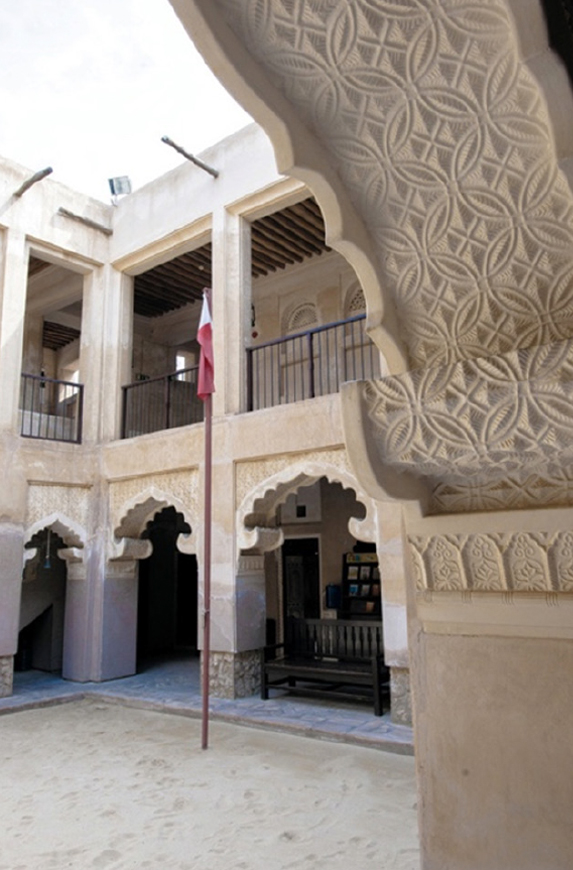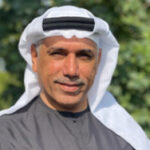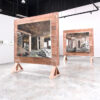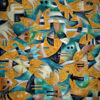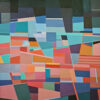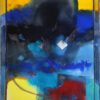He drew 100 portraits of rulers and public figures back in the fifties
- Devised classes for school activities, drawing, and events, and organized an annual festival for schools in Dubai.
- He was inclined towards the art of simulating nature and the local environment or simulating the sea, waves, and traveling ships.
- Among his works are writing in Chinese calligraphy, his impressive calligraphy skills in the Ruqah script, and writings on the ceilings of buildings.
We can’t precisely and accurately specify the actual beginnings of visual arts in the UAE. This is because the links that lead to knowledge of the history of art in this region extend between ancient and modern civilizations, and overlap between the inscriptions of the past and the inherited engraving arts, drawings, architecture, decorations, and others, all of which are deeply-rooted traditions.
However, for documentation purposes at least, we can refer to the beginnings of the painting movement in UAE in its modern sense; i.e. the arts of drawing, painting on canvas and paper in a contemporary style. As far as I know, the documents that monitor the beginnings of the formation of artistic phenomena in painting, in particular, are undocumented, and it is most likely that the interest in the art of Islamic calligraphy would have preceded arts due to the spread of classical education in the “kataatiib” at the beginning of the twentieth century and even before in the early stages of history. While it seems that fine art and drawing are a new phenomenon that came with the spread of formal education and modern schools.
Beginnings of Education
I won’t delve into the beginnings of education in UAE because it, alone, requires separate research, but we can point out that education began to spread across Dubai and Sharjah with the establishment of Al Ahmadiyya School in Dubai in 1912, and Al-Islah School and others in Sharjah in the year 1935. The curricula were limited to the basics of science in Fiqh, arithmetic, spelling, and Arabic calligraphy, while the arts, activities, and other sciences weren’t included until later.
In this article, we will discuss the history of one of the founders Mohammad Khalifa Dheban, of teaching calligraphy and source: Dr. Amina Dheban drawing at Al Ahmadiyya School in Dubai in the fifties, sixties, and seventies. Muhammad Khalifa Dhiban, teacher and artist, was the first teacher and founder of the drawing curriculum. Perhaps from his history, we can follow the thread that documents the history of arts in the Emirates.
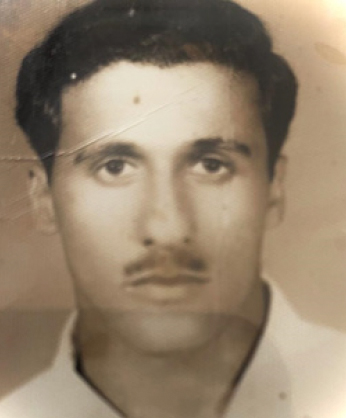
There is not enough information about the date of birth or death of this pioneer Emirati teacher, and all the available information that I have, I gleaned from members of his family; specifically, from his sister, Dr. Amina Dhiban, a professor of criticism and a well-known Emirati poet, who gave me a complete picture of the life of this artist and the most prominent stations in his life.
First Curriculums for Painting
Muhammad Khalifa Dhiban received his first education in the “kataatiib” (Koranic schools) and then studied under the guidance of imams and teachers who were the first and second generation of teachers in the Ahmadiyya School. Due to his desire to enlighten the community, he pledged himself after graduation to teach, despite his rejection of the formal teaching methods. He was one of the people who firmly adhered to the concept of experience and talent, and he called to renew the education, and abandon the old methods and components of education under which he studied. Although he was one of the pioneers of education in the Ahmadiyya School and the founder of the drawing classes, calligraphy, and school activity, he had his own view on the concept and methods of education. He was known for his passion for constant improvement, this could’ve been the reason for his popularity among students back then.
One of his most notable approaches at his time was his disapproval of the disciplinary teaching methods and refusal of beating in teaching, which was a common practice in formal education back then. He also didn’t keep track of the attendance and absence in his class, in a try to build trust between the student, the school, and the teacher. He also stood against reprimanding students and expelling them. Many people were impressed by his mentality and he became well-known as “Mr. Muhammad” or Muhammad Khalifa, when he was still sixteen years old. Among his most important works in this field is some writing on a school level. He also innovated school activity classes, and that was the beginning of his relationship with drawing and other activities, such as organizing an annual festival in all schools in Dubai, including Al-Shaab School in Bur Dubai, as an organizer and supervisor of school activities.
Also, another significant accomplishment mentioned by Dr. Amina Dhiban, the sister of this pioneering artist, is that in the field of painting, he was the first to specialize in portrait drawing in UAE. A form he was able to master and excel, so much that he managed to draw over 100 portraits, some of which were for rulers and public figures. One was a portrait of the late leader Gamal Abdel Nasser. He was also inclined towards the art of simulating nature and the local environment or simulating the sea, waves, and traveling ships in the distance, monitoring the movement of water, the flow of waves, dew drops, water gathering in ponds, and rain and clouds. He reached such a high level with his talent of imitation and simulation, and he managed to observe the meeting points between the earth and its terrains, and hand with brush, and the sources of cognition in the painting with the purification of color in its origin.
Dr. Amina also adds: He started with green and grey, mixed some colors, and presented the formation as a name. He did not mix the real with the imagined, but went with the literalism or thinking about the meaning to the extremes. He perfected the color of light and the beginning of black, or mixed joy with sadness. One of his favorite colors was grass color, which was the reason behind his intense love for his mother, like a child devoid of confidence, which was the beginning of his relationship with the inner self or the certainty of a promise; and we could name many more examples for that, the color of a female or the Abaya of women are constant themes and topics to him when it comes to the female entity or love.
It is also mentioned that Muhammad Khalifa was innovative when it came to understanding international paintings and interpreting the entrances to fine art; an obsession he shared with other colleagues at that stage, including Muhammad al-Luzumi, also known as Muhammad Salem.
Of his work, we can also mention writing in Chinese calligraphy, in addition to excelling in Ruqʿah and Naskh scripts. Some of his paintings were about the synchronization between Ruqʿah and Naskh scripts. He also founded the kindergarten school “Riyadh Al Atfal”, adopted Tajwid (Qur’an recitation), and wrote statements of enlightenment and calls of advocating or opposing on the ceiling; he participated himself in demonstrations that called for the evacuation of English colonialism from the Gulf.
Those many stations and details are in need of documentation, but most importantly, we have to search and dig deeper with the hope we can find these paintings and drawings left by this creative artist. We need to call for a more precise documenting of his biography, whether in the field of creativity, talent, and method of drawing, or in the field of education in which he excelled and continued his journey. The sources indicate that he moved from Al Ahmadhiyya School and the Al-Shaab School in Dubai to teach in the Shihuh areas in Ras Al Khaimah, including the areas of Al Yadi and Bukha, where he founded a school for educating both male and female students, and was a co-educational school.
A poet and writer from the 80s generation in UAE, he has published several books about art, poetry, theatre, and novel, including: “In light and shadow, and between them life”, a study on visual arts in the Emirates - Sharjah 2000.

